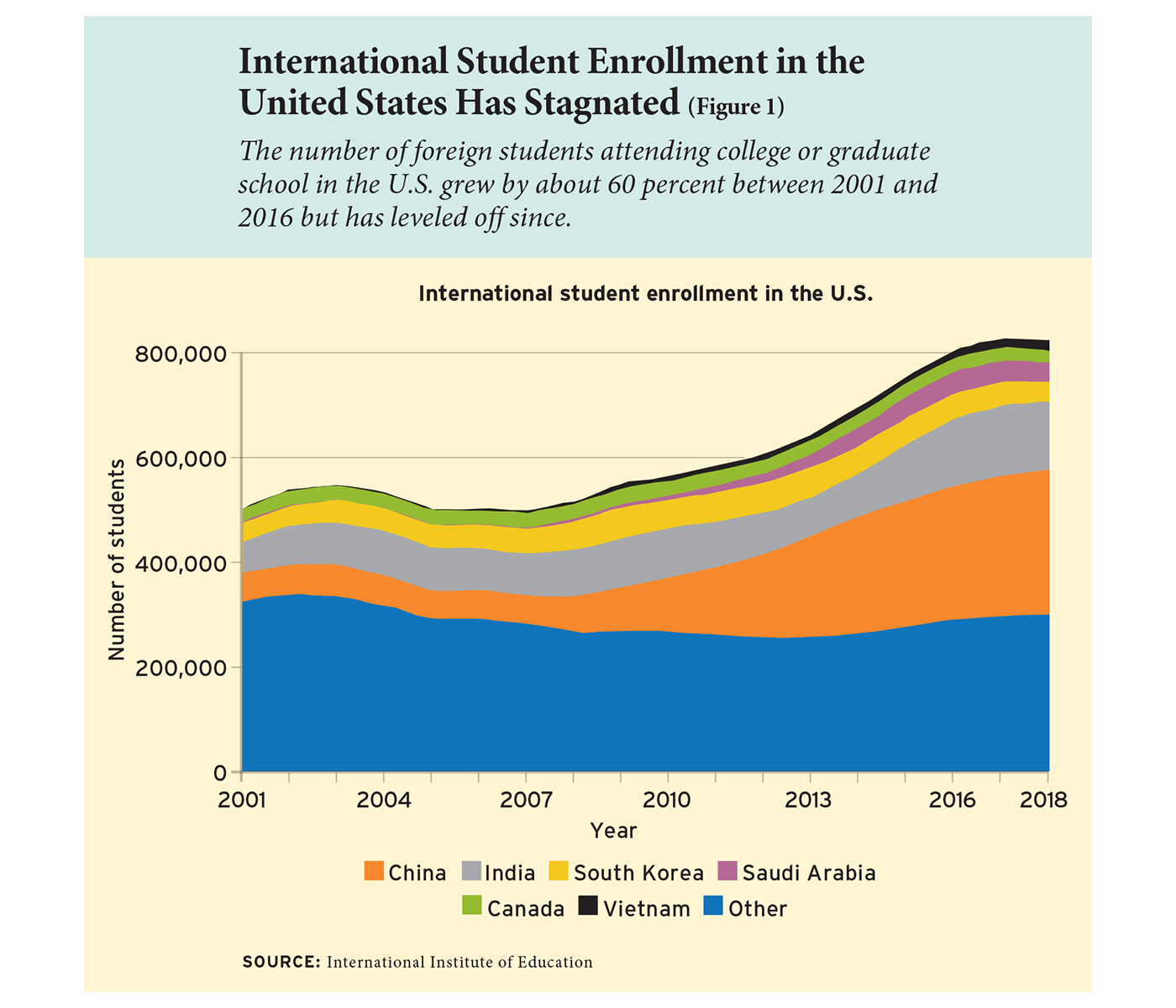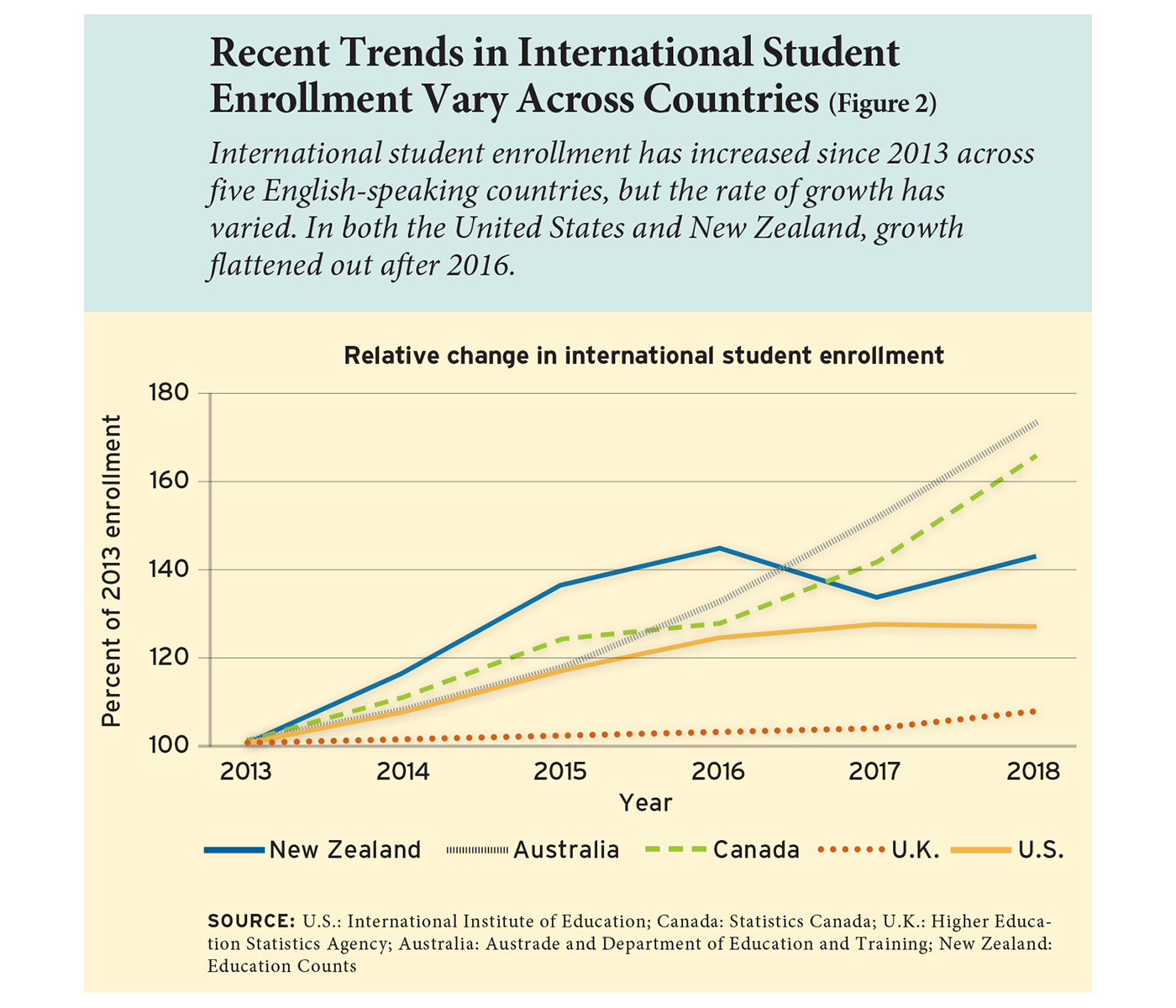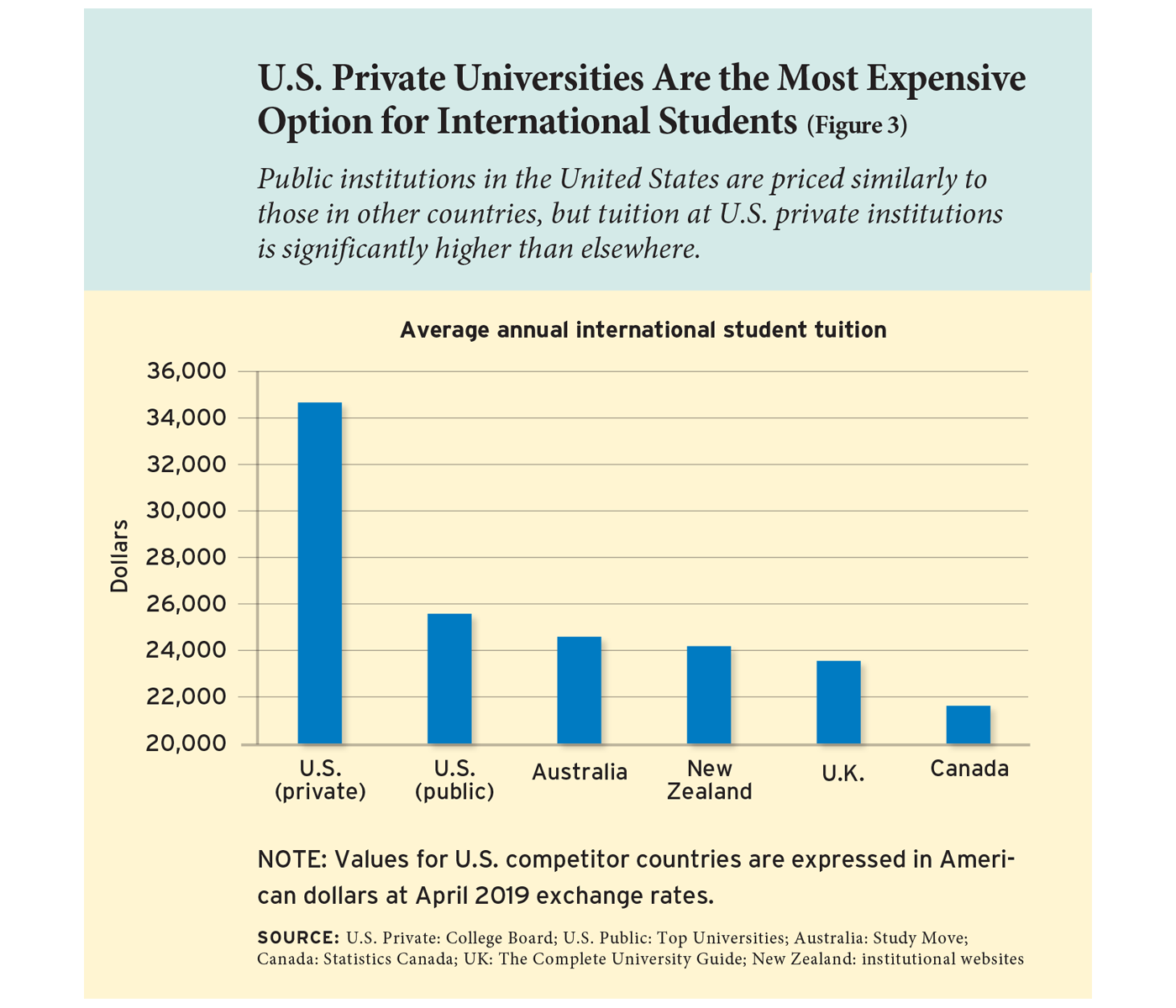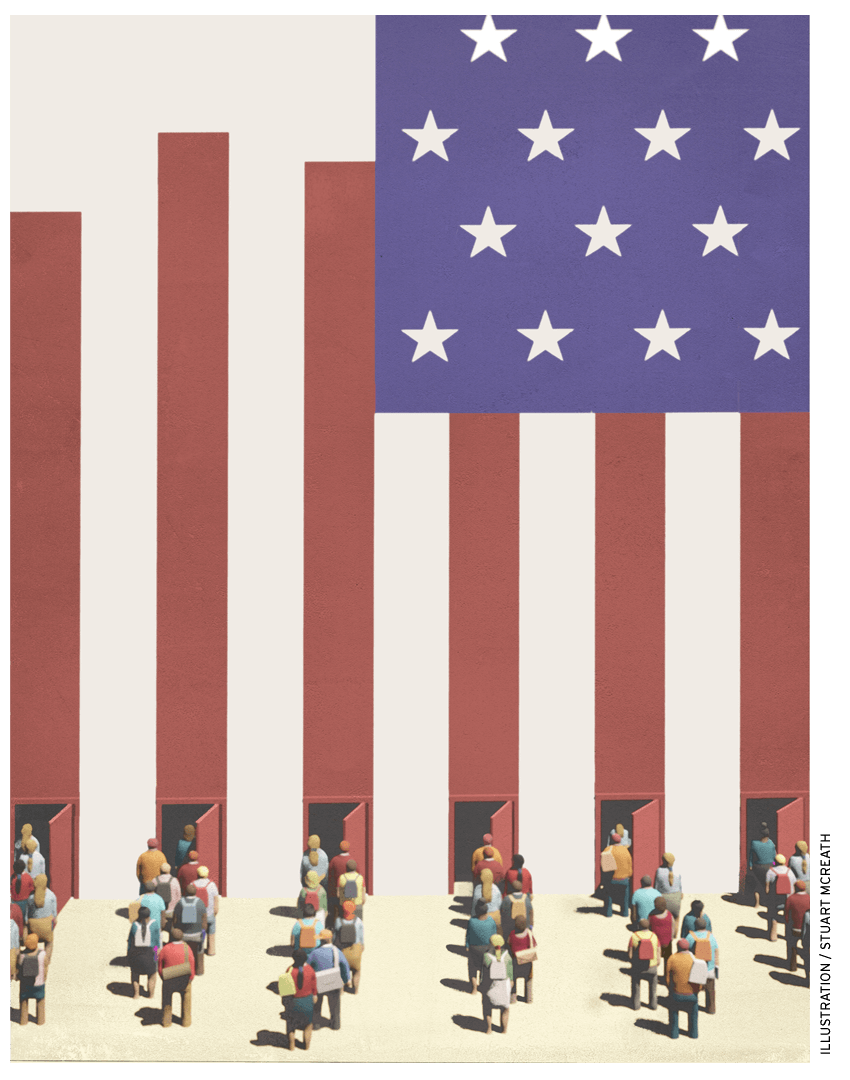 The United States has long been the world’s most popular destination for international students studying abroad. Yet in 2017–18, American universities sustained a 6.6 percent drop in new enrollments by foreign students, continuing a trend that began in 2015–16 and causing much handwringing in higher-education circles and the media. In covering the dwindling enrollment, the Wall Street Journal quoted a college-recruitment specialist as saying that foreign “students are not feeling welcome” in some states, while the Washington Post cited “questions about whether President Trump’s nationalist rhetoric and policies have undercut overseas demand for U.S. higher education.”
The United States has long been the world’s most popular destination for international students studying abroad. Yet in 2017–18, American universities sustained a 6.6 percent drop in new enrollments by foreign students, continuing a trend that began in 2015–16 and causing much handwringing in higher-education circles and the media. In covering the dwindling enrollment, the Wall Street Journal quoted a college-recruitment specialist as saying that foreign “students are not feeling welcome” in some states, while the Washington Post cited “questions about whether President Trump’s nationalist rhetoric and policies have undercut overseas demand for U.S. higher education.”
Is the United States losing its edge as the go-to place for study abroad?
A first glance at the numbers might suggest so, but a closer look discloses that while growth in the international-student market has slowed, the total numbers are trending upward. In 2018, the number of foreign students studying here attained a new high, exceeding one million for the third year running, according to the Institute of International Education. Furthermore, the country has experienced, and recovered from, growth-rate dips in the past.
For colleges and universities, “internationalization”—defined, for our purposes, as the recruiting and welcoming of foreign students—brings many benefits. Students from around the globe contribute diverse perspectives and cultural values to campus life. They also enrich the academic institution and the local economy through their spending on tuition, living expenses, and travel. For research institutions, the contributions of talented scientists and engineers in training are enormous. Thus, leaders in the higher-education sector have good reason to want to recruit these students. And they know they face strong competition for them from other English-speaking countries, such as Canada, the United Kingdom, and Australia.
It’s important to underline the distinctions between the two kinds of internationalization. Universities seek to attract top graduate students for their talent, but they pursue fee-paying students, many of them undergraduates, for a very different reason: to bring in revenue. As it happens, the recent decline in enrollment is not evenly distributed between these two categories.
Talent acquisition involves selecting the best students from around the world, mainly at the doctoral level, to work with professors at research institutions. American universities have excelled at this type of internationalization over the past six decades, largely because graduate students seek the unparalleled academic opportunities our institutions have to offer. The chance to work with the world’s top professors in some of the best-equipped academic laboratories has made the United States a magnet for up-and-coming scientists of promise.
This acquisition of top-notch talent, however, costs money—and lots of it. American universities waive tuition fees for these top graduate students and pay them healthy stipends. They do this because it is a good investment: it is no exaggeration to say that the American academic research enterprise, particularly in engineering, computer science, and pharmaceutical sciences, would be impossible to maintain without the labor of foreign doctoral students. When those students manage to stay in the United States—as professors, entrepreneurs, or simply highly skilled workers—they also make substantial contributions, economic and otherwise, to their communities and the country.
The second motive for internationalization is to generate surplus cash from international students to subsidize a college or university’s operations. This is now by far the dominant form of student mobility worldwide, but it is of comparatively recent origin. The United Kingdom was the first country to engage in this kind of recruitment on a mass scale when, during the 1980s, the government began to allow universities to charge international students substantial fees (tuition for domestic students was free until 1998). The Australians built on this approach in the 1990s when the government in Canberra openly encouraged institutions to find overseas students and charge them market-based tuition fees to make up for government cutbacks in education funding.
These two forms of internationalization target different markets. Talent acquisition operates nearly exclusively at the doctoral level. Revenue-enhancing efforts focus more on undergraduates and professional-master’s-degree candidates. The United States has long enjoyed healthy international enrollment in the talent-acquisition realm, but the innovation of the last few years has been a growth in the moneymaking sector of the market.
American universities did not chase this segment until recently, perhaps because raising tuition and bolstering operating revenue were never as problematic for American institutions as they were for British and Australian ones. Private institutions here turned more seriously toward recruiting fee-paying foreign students after the recession of 2001, at the same time they began to offer more domestic students heavy tuition discounts to convince them to enroll. Major public institutions took longer to enter the market. For them, the need for “high value” undergraduates was largely met by out-of-state students, until about the 2008 recession. Then, a sudden drop in state funding created a need for additional revenue exactly when families could least afford to spend more on tuition. Recruiting international students for what amounted to commercial purposes came to be seen as an “easy way out” of budgetary problems, and within five years a number of major state universities increased their share of international students from 3–4 percent of an incoming class to 15–20 percent.
The current changes in the inter-national-student market seem to have left the talent acquisition side of the equation mostly unaffected. What we see, for the most part, is a problem with revenue generation on the moneymaking side.
By the Numbers
The countries sending the most students to the United States are, in order, China, India, South Korea, Saudi Arabia, Canada, and Vietnam (see Figure 1). Students also come here from some 200 other countries around the globe. In the decade prior to 2016, international enrollment rose by about 60 percent. During that period, the composition of that enrollment changed dramatically, shifting to students from China and India. While these two countries previously accounted for about a quarter of international students, they now contribute almost 50 percent of the total. In fact, 97 percent of all growth in international enrollments since 2006 can be attributed to increases in numbers from just four countries: China, India, Saudi Arabia, and Vietnam.
Figure 1 also shows that since 2016, enrollment growth has ceased, and now the numbers may even be declining slightly. Still, the data do not justify declaring a “crisis” in international-student enrollment. Though growth has stagnated, the numbers of international students remain substantially higher than they were a decade ago. Furthermore, drops in foreign-student enrollment are nothing new: between 2003 and 2005 the numbers fell by a little more than 8 percent, but they began to rebound a few years later.
If international-student numbers remain near all-time highs, why are the media harping on the negatives? The reason is that news outlets are focusing on total-enrollment numbers, which tell only part of the story; there are other data sets in play. The first involves the number of international applications to U.S. universities. This is not tracked at the undergraduate level, but data from an annual survey by the Council of Graduate Schools show a fall in applications of about 7 percent over the past two years, concentrated mostly at the master’s-degree level. By contrast, applications to doctoral programs actually ticked upward over the same two years. The number of applications is also related to the research-intensiveness of the institutions: the “R1” institutions (the most research-intensive type of university in the Carnegie Classification system) have actually seen a rise in applications, while at master’s-level institutions the drop has been notable.
The other relevant set of data involves the measure of new enrollments, as distinct from total enrollments. Since most degrees take more than a year to complete, new enrollments don’t need to rise for total enrollments to do so: the number of new students just needs to equal or exceed the number of students leaving the system via graduation or dropping out. These numbers do not necessarily track precisely with changes in total enrollments, which institutions can raise by simply adjusting international-student admissions standards down to maintain a steady overall student-yield rate (though of course this has some potential ramifications for perceptions of prestige and selectivity). Thus, while applications from foreign students to American graduate schools fell by 7 percent, first-time enrollments decreased by only 2 percent, with the effects again felt more severely at less-selective institutions and at the master’s level. At the undergraduate level, what we see is a major drop in enrollments of 6–7 percent in 2017, with smaller declines in both 2016 and 2018. These dips are not yet large enough to make a dent in total enrollment (which rose very quickly in the four years prior to 2016), but they will start to cascade through the system over the next few years and reduce overall numbers, even if future new enrollments stabilize.
We can conclude from all this that there is some softness in the market in terms of both international applications and new enrollments and that decreases are related to students’ perceptions of institutional quality and prestige. And even if this softening is not yet evident in total enrollment numbers, it soon will be. The downward drift might be on the same scale as we saw in the mid-2000s, or it might be worse, if the weaker enrollment trends continue or intensify.
Comparative Picture
Is this market softness unique to America, or is it happening elsewhere as well? Global enrollment growth is slowing, driven particularly by plummeting youth cohort sizes in China, which have put the brakes on two solid decades of international-student enrollment increases. Perhaps—given demographic decline in China and the increased quality of institutions throughout Asia—there just aren’t as many international students out there for any market.
The question of whether the number of international students is falling can be dealt with relatively quickly by looking at students leaving China and India, who together constitute well over half the global flow of international students. Over the period of 2013–17, students from China in five English-speaking countries (the United States, the United Kingdom, Canada, Australia, and New Zealand) increased by 40 percent, while the number of Indian students in the same countries doubled. Though China and India have both seen massive increases in access to higher education over the past two decades, the supply of student slots at their domestic institutions has not grown nearly so much andhas not kept up with demand from a burgeoning middle-class in both nations. Numbers elsewhere may not be quite so impressive, but there is no major country where the number of students studying abroad is declining.
As to whether the situation in the United States is unique, we can uncover the answer by comparing American numbers to those of the same four other English-speaking countries. Figure 2 compares the evolution of U.S. international enrollments in 2013–18 to those of Australia, Canada, New Zealand, and the United Kingdom. It shows enrollment increasing quite steadily in Canada and Australia throughout the period, staying fairly constant in the United Kingdom, and, in the United States and New Zealand, increasing until 2016 and then flattening out.
The differences among these five countries fairly jump out of the figure. Canada and Australia have gone full out in recruiting fee-paying international students. However, both the United Kingdom and New Zealand have pursued policies that made it difficult for all higher-ed institutions to follow such a strategy. In the United Kingdom, the government has put up barriers to students who want to work in the country after graduation; in New Zealand, some private universities were prevented from recruiting, owing to concerns about the quality of the institutions. Are similar forces at work here? Though one cannot with any certainty determine from these cases the cause of the growth slowdown in the United States, one can say that the magnitude of the slump here is consistent with the flagging growth that has occurred when governments have taken steps to reduce the influx of foreign students, as happened in the United Kingdom and New Zealand.
A Trump Effect?
While there is solid evidence for a mild “recession” in international-student numbers, concentrated mainly in less research-intensive institutions, the question is, why is it happening? Admissions professionals are floating two non-exclusive explanations. The first is an apparent diminution of America’s appeal in many countries and—more concretely—a harsher visa regime in the United States. The visa situation can be placed squarely at the feet of the Trump administration. The president may also bear some responsibility for the overall drop in America’s attractiveness, though there is evidence that this decline started prior to his election. The second is high tuition costs. Both explanations have merit.
Figure 3 shows the average price of one year of undergraduate tuition for international students across our five comparison countries. Based on these data, one would not say that U.S. public institutions have priced themselves out of the market (though it is worth noting that these figures are averages, and there can be wide distribution around the mean), but private institutions here have clearly chosen a very high price point. High-prestige privates can continue to generate many applications even at steep prices, but one suspects that the less research-intensive and hence less-prestigious four-year privates may struggle if indeed there is some kind of “flight to quality” on the part of international students.
As for more Trump-related causes, these are more difficult to track directly. We know from various surveys from the Pew Research Center that America’s reputation abroad has suffered under Trump. The ICEF i-graduate Agent Barometer survey has documented a marked decline in the number of international-student agents rating the United States as a “very attractive” destination (from 67 percent in 2016 to 57 percent in 2018), though in fairness, the country’s numbers had begun falling prior to Trump’s election (in 2015 it was 77 percent). That these perception indicators are tracking downward at the same time that applications are decreasing is suggestive, but not conclusive. Because the U.S. government does not publish statistics on the rejection rate for student visas, it is impossible to tell whether State Department policies are leading immigration officials to be tougher during the visa approval process. We do know, however, that university officials themselves believe that visa issues are part of the problem. In 2018, 83 percent of institutions participating in the Institute of International Education’s annual “hot topics” survey reported visa delays and denials were a factor in declining numbers of international students; in 2016, only 34 percent said this.
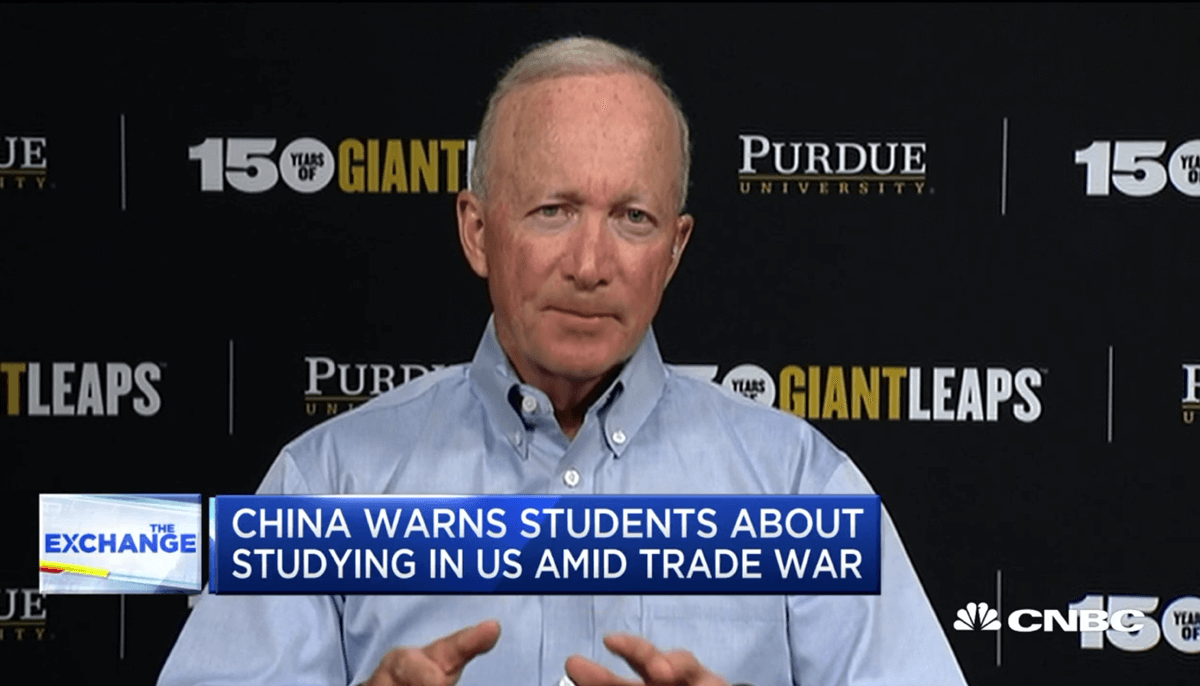
The Upshot
The evidence available to us suggests that there has been a modest waning in international applications to and new enrollments in American universities and colleges, perhaps on a scale equivalent to the decline seen in 2003–05. This drop has not become fully evident in the overall enrollment statistics, but it soon will. Based on international evidence, the size of the falloff here is consistent with those that have occurred elsewhere in the wake of a major government effort to let in fewer students from abroad.
The effect on talent acquisition—that is, on attracting the best students to the best universities—appears to have been minimal to nonexistent. The squeeze on institutional revenues, though, is a concern, especially for less-prestigious and less-selective institutions, where the effects have been concentrated. For private-sector institutions in this category, the comparative data on tuition fees suggest that the double whammy of lesser quality and high price point may be a problem. More generally, there is widespread concern about the Trump administration’s visa policies causing undue delays and denials of visas to prospective students.
If there is greater concern in the higher-ed sector about the decline in international-student numbers now than 15 years ago, when there was a comparable decrease, it is probably because international-student revenues make up a much larger proportion of most institutions’ budgets now. This shift has occurred not only because the foreign-student enrollments have risen; in private institutions, it is also a function of declining net revenues from domestic students after tuition discounting, and in public institutions it is also reflects declining government funding. Simply put, increasing the number of international students has been an important way for many institutions to maintain expenditure levels in the face of stagnating or declining domestic income sources.
How reasonable would it have been to presume that international-student growth might have continued indefinitely? Even if foreign-student enrollment numbers had continued to rise after 2016, eventually some public institutions would have hit levels where voters would have demanded a halt to such increases simply to preserve spaces in local universities for local students. That is what occurred in California in 2017, where the University of California board of regents adopted a set of rules capping out-of-state enrollment (including international students) at 18 percent, though campuses that were already beyond that limit were grandfathered. At some point, the relentless search for new revenue has to stop and the college-cost disease must be confronted more squarely. Perhaps this pause in international-student enrollment growth presents an occasion to do so.
Alex Usher is president of Higher Education Strategy Associates, a Toronto-based consultancy.
This article appeared in the Fall 2019 issue of Education Next. Suggested citation format:
Usher, A. (2019). Has President Trump Scared Away All the Foreign Students? The facts behind fears of a higher-education revenue recession. Education Next, 19(4), 40-46.


